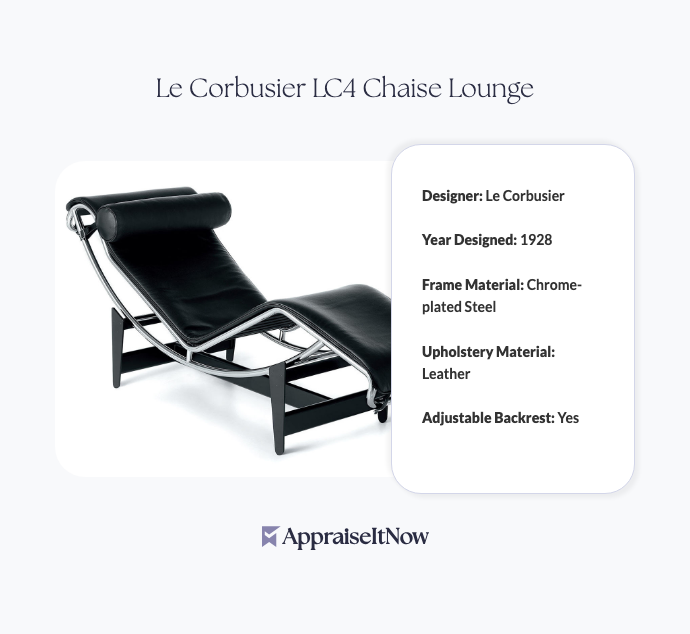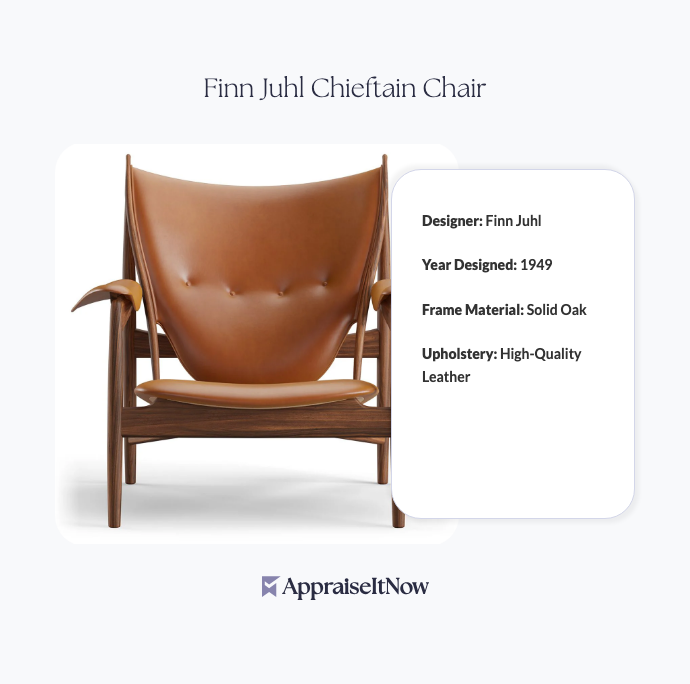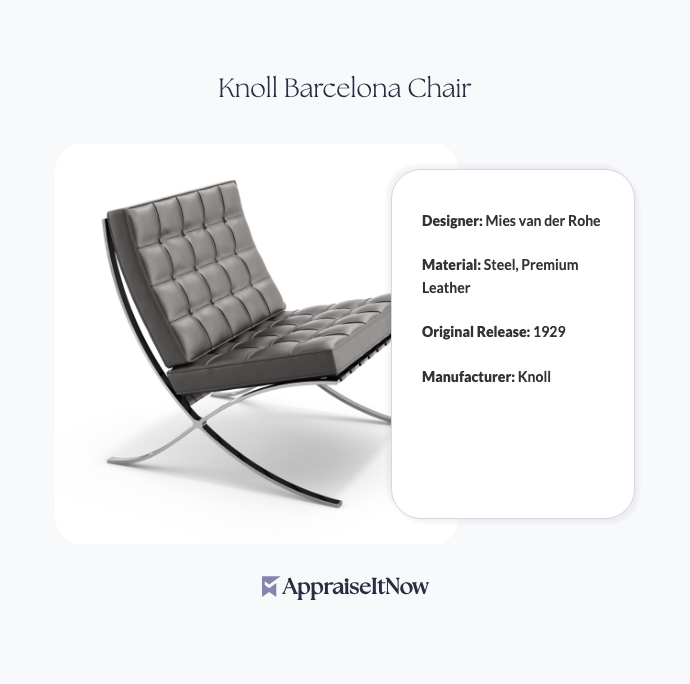<h1>How to Get Your Le Corbusier LC4 Chaise Lounge Appraised</h1>
<p>The Le Corbusier LC4 Chaise Lounge stands as one of the most iconic pieces of mid-century modern furniture, commanding significant market value between <strong>$10,000 and $40,000</strong> depending on condition, authenticity, and provenance. If you own one of these legendary design pieces or are considering purchasing one, obtaining a professional appraisal is essential for insurance, sale, or collection verification purposes.</p>
<h2>Understanding the LC4's Historical Significance</h2>
<p>Designed by the renowned Swiss-French architect Le Corbusier in 1928, the LC4 represents a watershed moment in furniture design. This wasn't simply a chair—it was a radical rethinking of how humans rest, combining ergonomic principles with sculptural beauty in a way that anticipated modern industrial design by decades. The LC4's sinuous form and innovative engineering made it immediately iconic, and that status has only solidified over nearly a century of collector interest.</p>
<div class="callout tip"><p><strong>Market Insight</strong></p>
<p>Original LC4 examples manufactured by Cassina during the 1960s-1980s typically command higher prices than contemporary reproductions, with documented provenance adding 15-25% to assessed values.</p></div>
<p>The piece's enduring appeal lies in several converging factors. Le Corbusier's design principles emphasized form following function, and the LC4 exemplifies this philosophy perfectly. The adjustable backrest responds to the human body's actual needs rather than imposing rigid geometry, making it genuinely comfortable—answering the frequent question of whether a Le Corbusier chaise lounge is actually comfortable. The answer is decidedly yes, which is why collectors value lived-in examples alongside pristine specimens.</p>
<h2>Key Features That Drive LC4 Appraisal Values</h2>
<p>When professional appraisers evaluate your LC4, they examine specific technical and material characteristics that directly influence market worth. The chaise lounge's construction from chrome-plated steel frames and high-quality leather upholstery reflects mid-century manufacturing standards that modern reproductions often struggle to replicate authentically.</p>
<p>The LC4 chaise lounge material composition matters significantly. Genuine examples feature tubular chrome-plated steel—not aluminum or painted substitutes—paired with leather (typically saddle leather) that develops patina rather than deteriorating. This distinction becomes crucial when distinguishing authentic pieces from replicas. The question of whether replica Le Corbusier chairs exist has an unfortunate answer: yes, countless reproductions flood the market, ranging from affordable "homages" to deceptive counterfeits. Professional appraisers distinguish originals from fakes through detailed material analysis and manufacturer documentation.</p>
<p>The story behind the LC4 chair reveals it emerged from Le Corbusier's broader investigation into modulor design—a proportioning system based on human dimensions. This wasn't accidental; every curve and angle serves ergonomic function. The key features of LC4 include its adjustable headrest supporting natural spinal alignment, the open frame design reducing visual weight in spaces, and the leather suspension system that distributes body weight efficiently. These engineering details directly affect value assessment.</p>
<table class='appraisal-table'>
<thead>
<tr>
<th>Feature</th>
<th>Original Specifications</th>
<th>Reproduction Shortcuts</th>
</tr>
</thead>
<tbody>
<tr>
<td>Frame material</td>
<td>Tubular chrome-plated steel</td>
<td>Painted steel or aluminum</td>
</tr>
<tr>
<td>Leather quality</td>
<td>Full-grain saddle leather</td>
<td>Split leather or vinyl</td>
</tr>
<tr>
<td>Joinery</td>
<td>Welded and polished joints</td>
<td>Riveted or bolted connections</td>
</tr>
<tr>
<td>Fasteners</td>
<td>Polished steel hardware</td>
<td>Plated or painted alternatives</td>
</tr>
</tbody>
</table>
<h2>Authenticating Your LC4 for Appraisal</h2>
<p>Before seeking professional valuation, understanding how to authenticate your piece prevents embarrassing—and financially significant—mistakes. The history of LC4 production spans decades, with different manufacturers producing versions under license, creating legitimate variations within the authentic market.</p>
<p>Cassina, the primary authorized manufacturer, produced LC4s with specific serial numbers and documentation. Examining your chaise lounge's underside reveals manufacturer stamps, patent dates, and production numbers that authenticators reference. Original Cassina examples from the 1960s-1970s carry substantially different values than 1990s-2000s reproductions, even when both bear legitimate licensing marks.</p>
<p>Professional appraisers from <strong>AppraiseItNow</strong> verify authenticity through multiple methods: material analysis, construction technique examination, documentation verification, and comparative assessment against museum examples. This rigorous approach protects you whether you're insuring valuable <a href="/types/furniture">furniture</a> or pursuing sale through reputable dealers. The question of how to authenticate Le Corbusier furniture requires technical expertise that distinguishes our certified appraisers from casual resellers.</p>
<div class="callout note"><p><strong>Authentication Insight</strong></p>
<p>Never assume a vintage-looking LC4 is original without professional verification. The combination of high desirability and manufacturing history makes thorough authentication essential for accurate appraisal values.</p></div>
<h2>Market Dynamics and Comparable Values</h2>
<p>The LC4 market demonstrates consistent demand from interior designers, museum institutions, and serious collectors. Recent auction results provide benchmarks that appraisers reference when establishing fair market value for your piece. Sotheby's and Christie's regularly feature LC4 examples, offering transparency about pricing at different condition levels.</p>
<p>Condition dramatically affects value within that $10,000-$40,000 range. Exceptional examples with original leather, minimal wear on chrome plating, and complete documentation command prices at the higher end. Pieces requiring restoration, suffering from worn leather, or lacking provenance settle toward the lower spectrum. This mirrors how <a href="/blog/the-basics-of-antique-furniture-appraisal">antique furniture appraisals</a> typically function—condition and completeness drive price more than age alone.</p>
<p>The best design of Le Corbusier remains hotly debated among architectural historians, but the LC4's consistent appearance on "greatest furniture design" lists reflects its universal recognition. This cultural significance supports stable market value and collector demand, protecting your investment more reliably than trendier contemporary pieces.</p>
<h2>Preparing Your LC4 for Professional Appraisal</h2>
<p>Maximizing your appraisal value begins with preparation. Gather any available documentation: original purchase receipts, auction house catalogs from previous sales, photographs showing the piece in historical contexts, or certificates of authenticity. While professional appraisers base valuations primarily on physical inspection and market analysis, supplementary documentation strengthens provenance narratives that boost value.</p>
<p>Clean your LC4 before appraisal, but gently—harsh cleaning can damage patina that collectors sometimes value. Use mild soap and soft cloth on leather, avoiding conditioning treatments that appraisers need to evaluate original material condition. Photographing your chaise lounge from multiple angles, including undersides and detail shots of any manufacturer markings, prepares you for the appraisal process and provides reference documentation for insurance purposes.</p>
<p>Understanding what expertise is necessary when appraising antique furniture helps you select qualified professionals. Look for appraisers with specific mid-century modern experience, USPAP compliance certification, and access to comparative sales data. Our <a href="/blog/furniture-appraisals-questions-to-ask-an-appraiser-before-booking">furniture appraisal resources</a> provide detailed guidance on vetting potential appraisers before engagement.</p>
<div class="callout tip"><p><strong>Preparation Tip</strong></p>
<p>High-resolution photographs of all surfaces, manufacturer markings, and any damage significantly accelerate the appraisal process while documenting current condition for future reference.</p></div>
<h2>Insurance and Collection Documentation</h2>
<p>Once appraised, your LC4 valuation supports proper insurance coverage that reflects its true replacement cost. Many standard homeowner's policies cap coverage for individual furniture pieces far below market value, leaving valuable design pieces underprotected. Professional appraisal documentation justifies increased coverage limits with insurance providers, ensuring financial protection if loss or damage occurs.</p>
<p>For collectors managing multiple pieces, comprehensive <a href="/blog/decoding-the-value-of-antique-furniture-materials-craftsmanship-and-historical-context">antique furniture appraisal</a> documentation creates a portfolio baseline against which future acquisitions and sales can be measured. This approach protects your overall collection value and supports informed acquisition decisions. The difference between casual furniture ownership and serious collecting often comes down to documentation—your LC4 appraisal becomes part of your collection's permanent record.</p>
<h2>Investment Perspective on LC4 Values</h2>
<p>The LC4 represents a compelling intersection of functional furniture and design investment. Unlike speculative art pieces subject to trend fluctuations, iconic furniture with proven international demand maintains relatively stable value appreciation. Historical data shows consistent demand from interior designers furnishing commercial and residential projects, educational institutions collecting design classics, and individual collectors seeking authentic mid-century examples.</p>
<p>This stability contrasts favorably with contemporary furniture that depreciates sharply post-purchase. Your LC4 doesn't just furnish space—it retains value over decades, potentially appreciating modestly as design continues gaining collector interest and investment portfolios diversify into tangible assets. Understanding <a href="/blog/appraising-contemporary-design-and-furniture-evaluating-modern-artistry">contemporary design and furniture evaluation</a> principles helps collectors recognize why certain pieces retain value while trendy contemporaries fade.</p>
<h2>When to Seek Updated Appraisals</h2>
<p>Market values fluctuate, particularly during economic transitions or when major auction results establish new benchmarks. Obtaining updated appraisals every 3-5 years maintains accurate insurance coverage and supports informed decisions about selling or acquiring complementary pieces. Significant life events—estate planning, insurance policy renewal, or collection expansion—warrant professional revaluation to ensure your documentation reflects current conditions and market dynamics.</p>
<div class="callout note"><p><strong>Key Takeaway</strong></p>
<p>A certified appraisal of your Le Corbusier LC4 Chaise Lounge provides essential documentation for insurance protection, accurate market positioning, and collection management. Whether you're verifying authenticity, planning an estate, or considering sale, professional appraisal services deliver the expertise and credible valuation that serious collectors and institutions require. <strong>AppraiseItNow</strong> connects you with certified furniture appraisers who understand mid-century modern design's nuanced value drivers, ensuring your iconic piece receives the expert evaluation it deserves.</p></div>







.avif)







